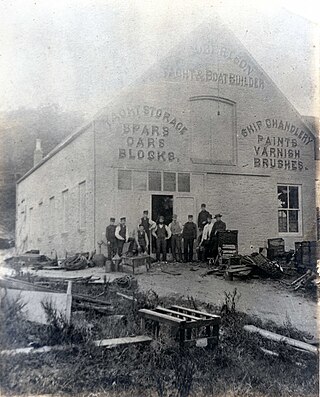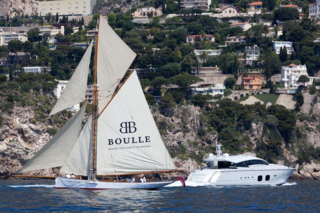Related Research Articles

William Fife Jr., also known as William Fife III, was the third generation of a family of Scottish yacht designers and builders. In his time, William Fife designed around 600 yachts, including two contenders for the America's Cup. The Royal Yachting Association was formed in 1875 to standardise rules, and Fife and his rival G.L. Watson, were instrumental in these rule changes. Around one third of Fife's yachts still exist. His last designs were built in 1938.
Tony Castro, Conde das Antas, Conde da Lousa, Visconde de Pernes, born 1952, is a yacht designer, known for numerous winning designs. Born in Lisbon, Portugal, he has been designing sailing and motor yachts since about 1980, with more than 10,000 boats launched, ranging from custom boats and one-design production models to superyachts. His design firm is based in Hamble-le-Rice, England.

Robert H. Perry is a U.S. yacht designer based in Seattle, Washington. Among his designs are some of the most successful cruising yachts in modern cruising such as the Tatoosh 42, Tayana 37 and Valiant 40. Through his career he has designed boats for many well recognized names in the yachting industry, such as Tayana, Cheoy Lee, Valiant, Baba, Ta Shing, Islander, Passport and Saga. Perry has taught yacht design at Evergreen State College.

A sailing yacht, is a leisure craft that uses sails as its primary means of propulsion. A yacht may be a sail or power vessel used for pleasure, cruising, or racing. There is no standard definition, so the term applies here to sailing vessels that have a cabin with amenities that accommodate overnight use. To be termed a "yacht", as opposed to a "boat", such a vessel is likely to be at least 33 feet (10 m) in length and have been judged to have good aesthetic qualities. Sailboats that do not accommodate overnight use or are smaller than 30 feet (9.1 m) are not universally called yachts. Sailing yachts in excess of 130 feet (40 m) are generally considered to be superyachts.

The Halcyon 23 is a British trailerable sailing boat that was designed by Alan Buchanan as a cruiser and first built in 1967.

Alexander Robertson & Sons was a boatyard in Sandbank, Argyll and Bute, Scotland, from 1876 to 1980. The yard was located on the shore of the Holy Loch, not far from the Royal Clyde Yacht Club (RCYC) at Hunters Quay, in the building that is now the Royal Marine Hotel, which was the epicentre of early Clyde yachting. Alexander Robertson started repairing boats in a small workshop at Sandbank in 1876, and went on to become one of the foremost wooden boatbuilders on Scotland's River Clyde. The "golden years" of Robertson's yard were in the early 1900s, when it started building some of the first IYRU 12mR & 15mR racing yachts. Robertson's was well known for the quality of its workmanship and was chosen to build the first 15-metre yacht designed by William Fife III. More than 55 boats were built by Robertson's in preparation for the First World War and the yard remained busy even during the Great Depression in the 1930s as many wealthy businessmen developed a passion for yacht racing on the Clyde. During World War II the yard was devoted to Admiralty work, producing a wide range of large high-speed Fairmile Marine Motor Boats. After the war, the yard built the successful one-class Loch Longs and two 12-metre challengers for the America's Cup: Sceptre (1958) and Sovereign (1964). Due to difficult business conditions, the Robertson family sold the yard in 1965, and it was turned over to glass-reinforced plastic production work until it closed in 1980. During its 104-year history, Robertson's Yard built 482 numbered boats, many of which are still sailing today.

Bowdoin Bradlee Crowninshield was an American naval architect who specialized in the design of racing yachts.

George Steers was a designer of yachts best known for the famous racing yacht America. He founded a shipyard with his brother, George Steers and Co, and died in an accident just as he was landing a major contract to build boats for the Russian Czar.
J W Miller & Sons Ltd was a boatbuilder in St Monans, Fife, Scotland for over 200 years. They produced a variety of fishing boats, yachts and motor launches. The firm built 110 Fifie yachts and was known worldwide for the quality and craftsmanship of their vessels. The yard is now closed.
Dixon Kemp, a British naval architect, was a founder of the Yacht Racing Association and at one time its secretary. He was a founder of Lloyd's Register of Yachts.

George Edwin William Monk was a shipwright and naval architect in the Pacific Northwest of the United States. He was active from 1914 to 1973. He designed pleasure and commercial vessels, both power and sail.

Alan Newbury Payne AM was a naval architect born in England but who worked in Australia. His yacht designs were readily built by both professionals and amateurs, and remain well represented in the ocean-going and coastal yacht fleet.
The Bell Boatyard was a boatbuilding facility which operated as part of Alexander Graham Bell's laboratories in Baddeck, Nova Scotia from 1885 to 1928. The boatyard built experimental craft, lifeboats and yachts during the first part of the twentieth century. The Bell yard was notable for its dual focus on both experimental and traditional boats and for its employment of large numbers of female boatbuilders.

Hodgdon Yachts is a builder of yachts and specialized military vessels, based in East Boothbay, Maine. It is a family-run business that was founded in 1816—the oldest continuously operating family boatbuilder in the United States, antedating the Burger Boat Company in Wisconsin. Hodgdon Yachts is noted for building superyachts, both sail and power, using advanced composite materials and construction techniques. It's also noted for its ability to incorporate those advanced materials into traditional designs that employ modern electronic and mechanical marine systems. The company has several divisions—yachts, custom tenders, yacht interiors, yacht services and military composites with offices in Boothbay, Maine, Newport, Rhode Island and Monaco.

Francis Charles Morgan-Giles was a boat designer and builder from Devon, England. He built rowing boats, dinghies, yachts and large motor cruisers. His boats were known for their high quality, elegance and craftsmanship.

The DynaRig is a conceptualization of a square-rigged form of rigging, designed in the 1960s by the German engineer Wilhelm Prölß. While having the appearance of the rigging of a 19th-century clipper ship, it was not actually implemented on a sailing vessel until several decades after its design because of a lack of adequate construction materials. It was fitted to one of the world's largest yachts, the Maltese Falcon. When the original patent rights and residual technology were purchased from the German government by an American investor in 2001, it was renamed the Falcon rig.
Edward George Dubois was a British yacht designer. He was the founder of Dubois Naval Architects and has been described as one of the foremost designers of sailing yachts.

Partridge is documented as being the world's oldest, still fully operational classic racing yacht.
Dennison J. Lawlor, was a 19th-century Canadian-Irish shipbuilder and yacht designer. He apprenticed under shipbuilder Whitmore & Holbrook. Lawlor had his own shipyard, building and designing for 40 years some of the finest yachts, pilot boats, and 150 merchant vessels built from his designs. The most notable were the Hesper, Florence, and D. J. Lawlor. Lawlor died in Chelsea, Massachusetts in 1892.
The Crystal 23 is a British trailerable sailboat that was designed by Alan Buchanan as a cruiser and first built in 1961.
References
- ↑ Ferris, Harriett (February 6, 2015). "Alan Buchanan, naval architect 1922 – 2015". Yachting World. Retrieved January 16, 2019.
- ↑ "Death of naval architect Alan Buchanan". Jersey Evening Post. February 18, 2015. Retrieved January 16, 2019.
- 1 2 3 4 5 6 7 "Buchanan Owners Association". www.buchananownersassociation.org. Retrieved March 15, 2022.
- ↑ McArthur, Bruce (2021). "Alan Buchanan 1922 - 2015". sailboatdata.com. Archived from the original on May 8, 2021. Retrieved May 8, 2021.
- ↑ |url https://www.maritimeviews.co.uk/databank/buchanan-plans/
- ↑ "Halcyon 23 - Yachts and Yachting Review", Offshore Yacht Class Owners' Association, March 13, 1970, archived from the original on January 5, 2009